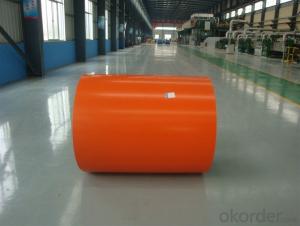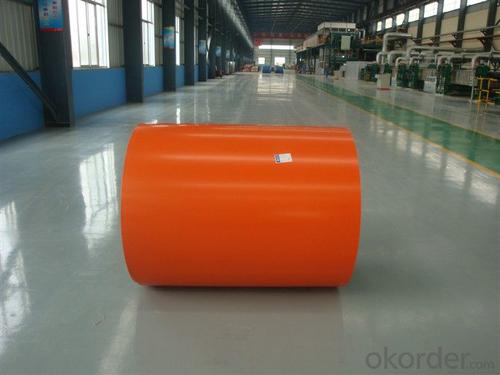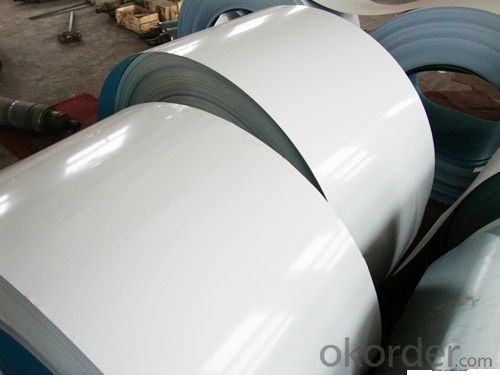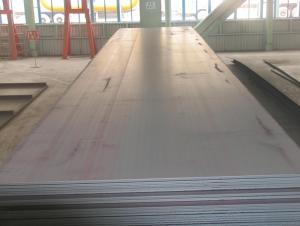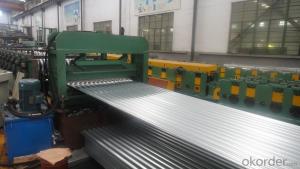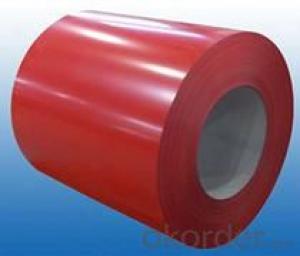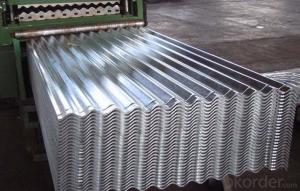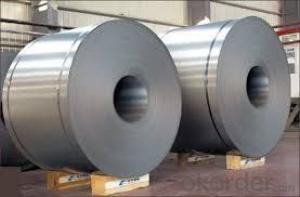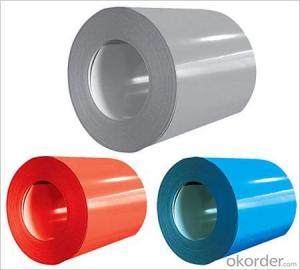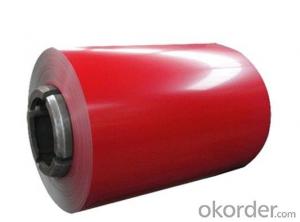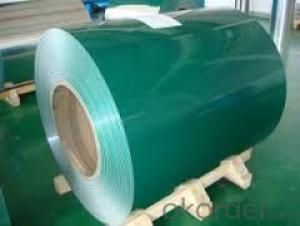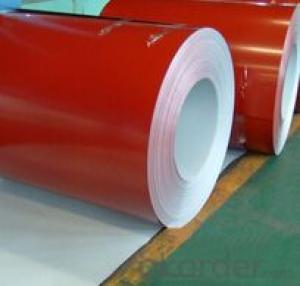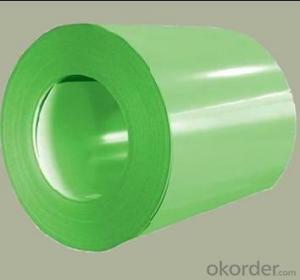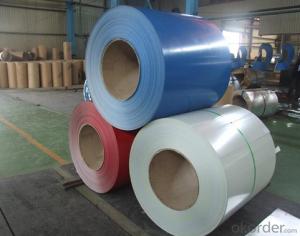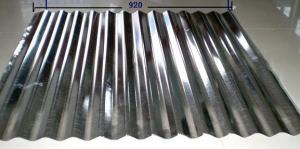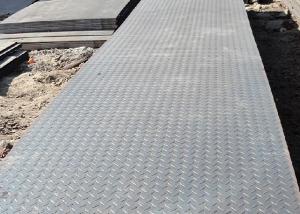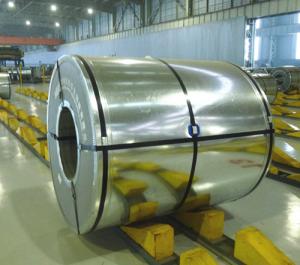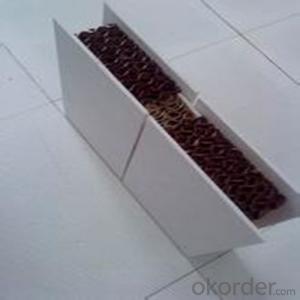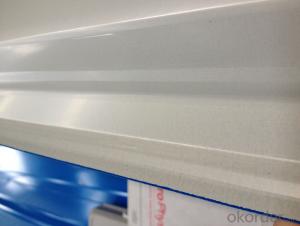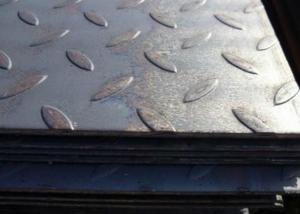FDPRE-PAINTED GALVANIZED STEEL COIL
- Loading Port:
- Tianjin
- Payment Terms:
- TT OR LC
- Min Order Qty:
- -
- Supply Capability:
- 8000 m.t./month
OKorder Service Pledge
OKorder Financial Service
You Might Also Like
PRE-PAINTED GALVANIZED STEEL COIL 7210490000 PRE-PAINTED GALVANIZED STEEL SHEET
THICKNESS:0.18mm-1.5mm
WIDTH:900mm-1250mm
COATING MASS:Z30-Z275
PAINT:PE、HP、HDP、PVDF、SMP、MATT、PVDF
COLOR:RAL Scale
COIL INNER DIAMETER:508mm/610mm
COIL WEIGHT:3mt-7mt
BASE MATERIAL:Hot-dip GALVANIZED Steel
In continuous units in cold rolled steel strip, galvanized steel (electro galvanized and hot dip galvanized) as substrate, after surface pretreatment (degreasing and science processing), using the method of roll coating, coated with a layer or multi-layer liquid coating of plate, after baking and cooling income is the coating steel plate. Because the coating can have a variety of colors, on the habits of the coated steel sheet is called color coating steel plate. Because the coating is carried out before the sheet metal forming, in foreign countries which is called pre coating plate.
Color coated steel sheet is an organic coating coating on the steel surface, it has the advantages of beautiful appearance, bright color, high strength, good corrosion resistance, easy processing molding, but also allows the user to reduce costs, reduce pollution.
From the United States in 1935 to establish the first continuously coated steel line to begin, color coated steel plate has been widely applied, the current color coated plate varieties, about more than 600 kinds, the advantages of color coated sheet and organic polymer and steel plate of the two, which has good colorability, organic polymer molding, corrosion resistance and decorative, and steel plate with high strength and easy processing, can easily be punching cutting, bending, deep drawing processing. Made this makes organic coated steel sheet products have excellent practical, decorative, workability, durability.
- Q: What is the difference between a steel sheet and a steel plate?
- The main difference between a steel sheet and a steel plate is their thickness. Steel sheets are generally thinner, ranging from 0.4mm to 6mm, while steel plates are thicker, typically starting from 6mm and can go up to several inches in thickness. Additionally, steel plates are often used for structural purposes or heavy-duty applications, while steel sheets are commonly utilized for lighter applications like roofing, cladding, or decorative purposes.
- Q: What is the difference between coated and uncoated steel sheets?
- Coated and uncoated steel sheets differ primarily in terms of their protective layer and surface finish. Coated steel sheets, also known as galvanized steel sheets, are coated with a layer of zinc to prevent corrosion and increase durability. This zinc coating acts as a sacrificial layer, protecting the underlying steel from rust and other forms of damage. Additionally, coated steel sheets have a smoother and more polished appearance. On the other hand, uncoated steel sheets are not treated with any protective layer. This makes them more susceptible to corrosion, especially when exposed to moisture or chemicals. Uncoated steel sheets are often used in applications where corrosion resistance is not a significant concern, such as in construction projects where the steel will be covered or protected in some way. In terms of cost, coated steel sheets are generally more expensive than uncoated steel sheets due to the additional manufacturing process involved in applying the zinc coating. However, the added cost is justified by the enhanced durability and extended lifespan of coated steel sheets. In summary, the main difference between coated and uncoated steel sheets lies in the presence of a protective layer. Coated steel sheets offer superior corrosion resistance and have a smoother appearance, while uncoated steel sheets are more vulnerable to corrosion and have a rougher surface finish.
- Q: Can steel sheets be used for manufacturing automotive parts?
- Yes, steel sheets can be used for manufacturing automotive parts. Steel sheets are widely used in the automotive industry due to their strength, durability, and cost-effectiveness. They can be easily formed, welded, and shaped into various automotive components such as body panels, chassis parts, and structural elements.
- Q: Can steel sheets be used in food-grade applications?
- Yes, steel sheets can be used in food-grade applications. Stainless steel sheets are commonly used in various food processing and handling equipment, as they offer excellent resistance to corrosion, durability, and ease of cleaning.
- Q: What is the thickness of the water resisting steel plate of the electrical outlet?
- The water resisting steel plate of the electric door mainly meets the need of welding between the sleeve and the setting of the water stopping line.
- Q: Can steel sheets be heat treated for increased hardness?
- Yes, steel sheets can be heat treated to increase their hardness. Heat treatment is a process used to alter the physical and mechanical properties of steel, including hardness. The most common heat treatment method used for increasing the hardness of steel sheets is called quenching and tempering. During this process, the steel sheets are heated to a high temperature and then rapidly cooled by quenching in a suitable medium, such as oil or water. This rapid cooling helps to transform the steel's microstructure, resulting in increased hardness. However, this sudden cooling can also introduce internal stresses in the steel, making it brittle. To overcome this brittleness, the quenched steel sheets are then tempered by reheating them to a specific temperature and holding it for a certain period of time. Tempering allows the steel to regain some of its ductility while retaining the desired hardness. It is important to note that the specific heat treatment process and parameters used for steel sheets depend on the composition and intended application of the steel. Different steel alloys require different heat treatment processes, and the temperature and time parameters may vary accordingly. Therefore, it is crucial to consult with an expert or refer to the steel's technical specifications to determine the appropriate heat treatment process for achieving the desired hardness.
- Q: Are the steel sheets susceptible to rusting?
- Yes, steel sheets are susceptible to rusting as steel is prone to corrosion when exposed to moisture and oxygen.
- Q: What is the difference between stainless steel and regular steel sheets?
- Stainless steel and regular steel sheets differ primarily in their composition and properties. Stainless steel is an alloy made from a combination of iron, chromium, and other elements such as nickel and molybdenum. Regular steel, on the other hand, is primarily composed of iron with small amounts of carbon and other impurities. The key difference between stainless steel and regular steel sheets lies in their corrosion resistance. Stainless steel is highly resistant to corrosion due to the presence of chromium, which forms a protective layer on its surface when exposed to oxygen. This layer, known as a passive film, prevents the steel from rusting and makes it suitable for applications in environments with high moisture or chemical exposure. Regular steel sheets, on the other hand, are prone to corrosion as they lack the protective chromium layer. They may require additional coatings or treatments to enhance their corrosion resistance. Without proper protection, regular steel sheets can rust and deteriorate over time when exposed to moisture or corrosive substances. Another difference between stainless steel and regular steel sheets is their strength and hardness. Stainless steel is generally stronger and more durable than regular steel due to its alloy composition. It can withstand higher temperatures and has better resistance to wear and tear. Regular steel, although strong, may not offer the same level of strength and durability as stainless steel. The aesthetic appeal is another contrasting factor between the two. Stainless steel sheets have a shiny, reflective surface that gives them a modern and sleek appearance. They are often used in architectural and decorative applications where visual appeal is desired. Regular steel sheets, on the other hand, have a more dull and matte finish and are primarily used for structural and industrial purposes rather than for their visual appeal. In summary, stainless steel sheets offer superior corrosion resistance, strength, and aesthetic appeal compared to regular steel sheets. They are a preferred choice for applications where durability, hygiene, and maintenance-free performance are required, such as in kitchens, medical equipment, automotive parts, and construction projects. Regular steel sheets, while less expensive, may require additional protection and are commonly used in structural and industrial applications where corrosion resistance and visual appeal are not primary concerns.
- Q: Are steel sheets suitable for noise barriers or soundproofing?
- Yes, steel sheets can be suitable for noise barriers or soundproofing. Steel is a dense material that effectively blocks sound waves, making it an effective choice for reducing noise transmission. Additionally, steel sheets can be easily installed and offer durability, making them a practical option for noise control applications.
- Q: Are the steel sheets coated with any protective material?
- Yes, the steel sheets are coated with a protective material. The protective coating is typically applied to the steel sheets to enhance their durability and resistance to corrosion. This coating acts as a barrier between the steel surface and external elements such as moisture, chemicals, and weather conditions, preventing the steel from rusting or corroding. The protective material can vary depending on the specific application and requirements, but it is commonly a layer of zinc or zinc-alloy coating, known as galvanized coating. This coating provides excellent protection to the steel sheets and extends their lifespan, making them suitable for various industries and applications.
Send your message to us
FDPRE-PAINTED GALVANIZED STEEL COIL
- Loading Port:
- Tianjin
- Payment Terms:
- TT OR LC
- Min Order Qty:
- -
- Supply Capability:
- 8000 m.t./month
OKorder Service Pledge
OKorder Financial Service
Similar products
Hot products
Hot Searches
Related keywords
